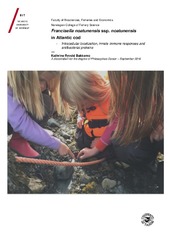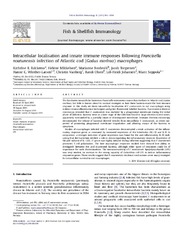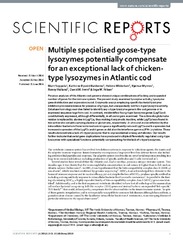| dc.contributor.advisor | Robertsen, Børre | |
| dc.contributor.author | Bakkemo, Kathrine Ryvold | |
| dc.date.accessioned | 2016-11-17T09:40:07Z | |
| dc.date.available | 2016-11-17T09:40:07Z | |
| dc.date.issued | 2016-11-24 | |
| dc.description.abstract | SUMMARY
Francisellosis has in the cod farming industry caused big economic losses because of no available vaccine or treatments. Understanding host-pathogen mechanisms is especially important when traditional vaccine strategies using inactivated bacteria are not functional.
The focus of this thesis has been to study interactions between the host and the pathogen causing the disease. The bacterium Francisella noatunensis subspecies noatunensis (here after called F. noatunensis) is the causative agent and a special feature with this particular pathogen is the intracellular lifestyle and the invasion of immune cells which are designed to kill pathogens. Cod macrophages were used as tools to investigate bacterial invasion, localization of the bacterium in the host cell, survival and replication. Additionally, expression of immune and antibacterial genes was measured after infection with the bacteria. LPS from both F. noatunensis and E. coli was used as immune stimulants and activation of macrophages with gamma interferon (IFN-γ) was conducted. Investigation of invasion, survival and replication of F. noatuensis in a cod cell line of epithelial-like cells (ACL-cells) were also included.
Important findings are that F. noatunensis is able to survive and replicate in both cod macrophages and ACL-cells. Inside macrophages the bacteria seems to release vesicles, disrupt the phagosomal membrane and escape into the cytosol. Pro-inflammatory responses in cod macrophages appeared to be low while an anti-inflammatory response was higher. Also F. noatunensis LPS are a poor inducer of pro-inflammatory cytokine in contrast to E.coli LPS. The low induction of inflammatory responses after F. noatunensis infection or treatment with its LPS, suggests that this bacterium may have evolved virulence mechanisms to subvert host immune responses in cod.
Uptake of the pathogen in macrophages is dependent of actin filaments and temperature appears important in invasion of cod macrophages. It has become clear that fish possess a well-functioning interferon system to regulate host defence against viral infections and also intracellular bacteria. Recombinant (r) IFN-γ from cod seemed to activate cod macrophages to increased uptake of F. noatunensis followed by a reduction of intracellular bacteria.
In addition, natural antibacterial peptides, produced by the organisms itself, were investigated. Lysozyme, cathelicidin and hepcidin were chosen as they are all identified in cod. Multiple goose-type (g-type) lysozyme genes have been found in cod and can be products of gene duplications. Analysis showed that cod seems to lack chichen-type lysozyme in contrast to other fish like Atlantic salmon. Investigation further revealed that all three types of the studied antibacterial peptides are involved in cod host defence mechanisms in vivo. Infection of cod macrophages (in vitro) confirms the importance of g-type lysozyme, while expression of cathelicidin and hepcidin genes was at the same level as control. Even though both hepcidin and cathelicidin have antimicrobial roles in mammalian phagocytic cells it looks like F. noatunensis does not trigger expression of these genes in cod macrophages. This could mean that other cells or systems than macrophages are causing cathelicidin and hepcidin amplification in cod. G-type lysozyme on the other hand seems important in defence mechanisms in cod macrophages and several issues indicate an intracellular role of this peptide. | en_US |
| dc.description.doctoraltype | ph.d. | en_US |
| dc.description.popularabstract | SAMMENDRAG
Francisellose har skapt store økonomiske tap ved oppdrett av torsk grunnet mangelen på både vaksine og behandling. Siden bruk av tradisjonell vaksinestrategi med inaktiverte bakterier ikke fungerer, er det spesielt viktig å bedre kunnskapen om vert-patogen mekanismen.
Fokuset i denne avhandlingen har vært å studere interaksjoner mellom verten og bakterien som forårsaker sykdommen. Det er bakterien Francisella noatunensis underart noatunensis (heretter kalt F. noatunensis) som er årsaken til sykdommen og spesielt for denne bakterien er dens intracellulære livsstil og invasjon av immunceller som i utgangspunktet er designet til å drepe patogener. Torskemakrofager ble brukt til å studere bakterieinvasjon, bakteriens lokalisering i vertscellen, overlevelse og replikasjon, i tillegg til utrykk av immungener og antibakterielle gener etter infeksjon med bakterien. LPS fra både F. noatunensis og E. coli ble brukt som immunstimulanter og aktivering av makrofager med interferon gamma (IFN-γ) ble utført. Det ble også inkludert en cellelinje på torsk med epitellignende celler (ACL-celler) for å studere invasjon, overlevelse og replikasjon av F. noatunensis i disse cellene.
Viktige funn er at F. noatunensis er i stand til å overleve og formere seg i både torskemakrofager og ACL-celler. Inne i makrofagene ser det ut til at bakterien skiller ut vesikler, ødelegger den fagosomale membranen og rømmer ut til cytosol. Pro-inflammatoriske responser i torskemakrofager synes å være lave mens anti-inflammatoriske responser var høyere. LPS fra F. noatunensis fremkaller også lavt genuttrykk av pro-inflammatoriske cytokiner i motsetning til hva LPS fra E. coli gjør. Denne svake inflammatoriske responsen etter både infeksjon med F. noatunensis eller behandling men bakteriens LPS kan tyde på at bakterien har utviklet mekanismer for å unngå vertens immunresponser.
Opptak av bakterier i makrofager er avhengig av aktinfilamenter og temperatur ser ut til å ha en innvirkende kraft på invasjonen i torskemakrofagene. Det er kjent at fisk har et velfungerende interferonsystem for å regulere vertens forsvar mot virusinfeksjoner i tillegg til intracellulære bakterier. Rekombinant (r) IFN-γ fra torsk ser ut til å aktivere torskemakrofagene til økt opptak av F. noatunensis etterfulgt av en reduksjon av intracellulære bakterier.
I tillegg ble naturlige antibakterielle peptider som verten selv produserer studert. Lysosym, katelicidin og hepsidin ble valgt med bakgrunn i at de er funnet i torsk tidligere. I torsk er det funnet mange såkalte «goose-type» (g-type) lysosymgener som kan være produkter av genduplisering. Ifølge analysene ser det ut til at torsk, i motsetning til Atlantisk laks, mangler «chichen-type» lysosym. Videre viser undersøkelsene at alle tre typene av de studerte antibakterielle peptidene er involvert i torskens forsvarsmekanismer in vivo. Infeksjon av torskemakrofager (in vitro) bekrefter betydningen av g-type lysosym, mens utrykk av katelicidin- og hepsidingener hadde samme nivå som kontrollen. Selv om katelicidin og hepsidin har en antimikrobiell rolle i fagocytter hos pattedyr, ser det ut til at F. noatunensis ikke trigger utrykk av disse genene i torskemakrofager. Dette kan bety at det er andre systemer enn fagocyttene som produserer katelicidin og hepsidin under infeksjonen in vivo i torsk. G-type lysosym ser derimot ut til å være en viktig forsvarsmekanisme i torskemakrofager og flere ting tyder på at peptidet har en intracellulær rolle. | en_US |
| dc.description.sponsorship | The Research Council of Norway grant no. 199672/E40 | en_US |
| dc.description | The paper 2 of this thesis is not available in Munin. <br>
Paper II: Bakkemo, K. R., Mikelsen, H., Johansen, A., Robertsen, B., Seppola, M.: «Francisella noatunensis subsp. noatunensis invade, survive and replicate in Atlantic cod cells”. Available in <a href=http://dx.doi.org/10.3354/dao03043>Diseases of Aquatic Organisms 2016, 121(2):149-159. </a> | en_US |
| dc.identifier.isbn | 978-82-8266-127-0 | |
| dc.identifier.uri | https://hdl.handle.net/10037/9973 | |
| dc.language.iso | eng | en_US |
| dc.publisher | UiT The Arctic University of Norway | en_US |
| dc.publisher | UiT Norges arktiske universitet | en_US |
| dc.rights.accessRights | openAccess | en_US |
| dc.rights.holder | Copyright 2016 The Author(s) | |
| dc.subject.courseID | DOKTOR-002 | |
| dc.subject | VDP::Landbruks- og Fiskerifag: 900::Fiskerifag: 920::Akvakultur: 922 | en_US |
| dc.subject | VDP::Agriculture and fishery disciplines: 900::Fisheries science: 920::Aquaculture: 922 | en_US |
| dc.title | Francisella noatunensis ssp. noatunensis in Atlantic cod - Intracellular localization, innate immune responses and antibacterial proteins | en_US |
| dc.type | Doctoral thesis | en_US |
| dc.type | Doktorgradsavhandling | en_US |


 English
English norsk
norsk

